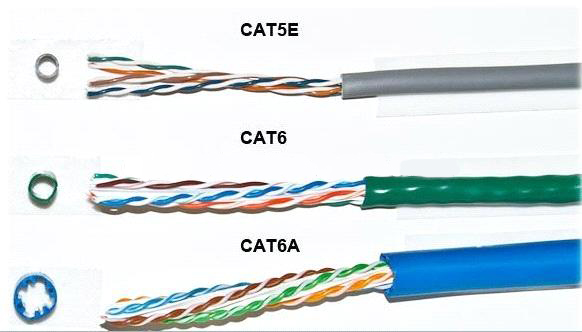Copper is the oldest installed cable and it’s still widely used for connecting devices. Till now, copper cable has gone through several generations to meet people’s increasing needs of different sides. There are many types of copper cables offering different performance such as Cat 5e, Cat 6 or Cat 6a. What kind of copper cabling should you choose? This is a really confusing question people usually meet today. This article will introduce some details about these three kinds of copper cables and help you make your decision.

Cat 5e
Cat 5e, also known as Enhanced Category 5, is designed to support full-duplex Fast Ethernet operation and Gigabit Ethernet. In 1998, Gigabit Ethernet was introduced. Then, the original Cat 5 was found not good enough to guarantee error-free performance. So extra requirements were added to Cat 5, such as Return Loss, Delay, Delay Skew and Power Sum Crosstalk measurements. With these improved parameters, Cat 5e came into being to ensure reliable operation of Gigabit Ethernet. The electrical performance for Cat 5e requirements is up to 100MHz.
Cat 6
Cat 6 was designed as the next generation to Cat 5e. It has higher standards construction than Cat 5e with a bandwidth of up to 250 MHz rather than 100 MHz. It can support the faster protocols and is therefore considered more reliable than Cat 5e. It is ideal for 10 Gigabit Ethernet transmissions.
Cat 6a
Cat 6a has a bandwidth of up to 500 MHz and is designed to support 10 Gigabit Ethernet transmissions over 100 meter channel. It’s also compatible with Cat 5e and Cat 6. A new electrical parameter measure of “alien crosstalk”, which is a measurement of the noise crosstalk generated from neighboring cables, was introduced to ensure that Cat 6a cabling system can run 10 Gigabit Ethernet transmissions well.
Common Features of Three Types
The three kinds of cables are unshielded twisted pair (UTP) or shielded twisted cables. They use 4 twisted pairs in a common jacket and the same RJ-45 jacks and plugs. And they are limited to a cable length of 100 meters including the length of the patch cables on either end of the link. The parts are interchangeable. That means you can use a Cat 5e patch cable with Cat 6 house cabling. But your system will perform at the lowest link level.
Differences of Three Types
The most noticeable difference of these cables is the price. According to statistics, plan on Cat 6 will cost roughly 30% more than Cat 5e and Cat 6a 30% more than Cat6. But the price is not the only factors to decide which kind of cable should be used.
- Transmission Performance: Cat 5e has a bandwidth of up to 100 MHz. It has a reduced maximum length of 45 meters when used for 10 Gigabit Ethernet applications. Cat 6 cable is rated for 250 MHz. It can support 10 Gigabit Ethernet up to 55 meters. While Cat 6a performs at up to 500 MHz, so it allows 10 Gigabit Ethernet to be run over distances of up to 100 meters. Cat 6a has a better transmission performance than Cat 6 and Cat 5e. But this doesn’t mean the network ‘speed’ of Cat 6a is faster. These are electrical performance differences.
- Crosstalk: Crosstalk is a complicated subject to grasp and has been talked before. It is the phenomenon in which a signal from one channel or circuit interferes with another channel or circuit's signal. Cat 6 cable has lower signal degradation from near-end crosstalk (NEXT), power sum NEXT (PS-NEXT) and attenuation than Cat 5e. Cat 6a reduces this to an even lower level.
- Physical Properties: Cat 6a has bigger size and more weights than Cat 5e and Cat 6. It will take up more space for installation. And because of the larger cable diameter, Cat 6a needs a bigger bend radius. So it’s important to allow extra space anywhere for Cat 6a cables. Since it's capable of speeds up to 500 MHz and Alien Crosstalk begins at only 350 MHz, Cat 6a needs more testing.
Which One Should You Choose?
For most of copper network applications, Cat 5e is good enough to give all the performance we are likely to need today. But if you are looking for a cable for your future needs, then Cat 6a will give you the best performance at full distances. So it depends on what you will do with the cable. You should also consider the price and space.
Originally published at www.fiber-optic-equipment.com
No comments:
Post a Comment